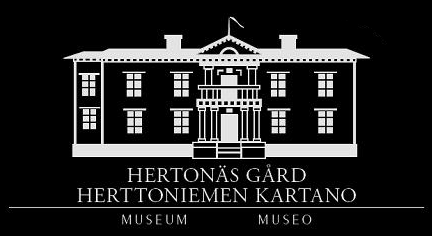In the archives at Hertonäs manor, there’s a photograph of a so called sytarstuga, a retirement cottage, taken by photographer Irene Wahlberg at the turn of the century in 1900.
The Guss homestead, Martinkylä/Mårtensby. Retirement cottage. In front of the cottage sits Vilhelmina Hellman 66. Her daughter Emilia Blomqvist, nee Hellman, 29, is standing in the centre. To the right sits Vilheminas granddaughter Edit, whose mother Alexandra Josefina died aged 29 in 1889. The photo is number 24, collection 101, Helsinge 1900.
A retirement cottage was often built by a couple before they signed over their farm, or by the new owner who had it constructed for his elderly parents (or unrelated contract signees, perhaps as part of the retirement agreement). It might have been very attractive for an elderly couple to have their own smaller building to live in – a smaller space is easier to heat, and distances are shorter. The cottage was probably close to the main building as well, making it easier to ask for assistance.
The arranging of this new living situation wasn’t all smooth sailing though – studies of surviving diaries and other materials reveal that some elderly parents weren’t happy with food provided them, thought they were being disrespected by their children and/or their partners, or just disagreed with how their family farms were being run. Management of the farm, the status and roles of its inhabitants, and the treatment of the elderly seems to have been sore points that potentially caused friction between family members. Sometimes, especially towards the end of the 19th century, the elderly did not have their own building to live in but stayed in the main house with the new head of the household – which probably didn’t help matters. Retirement contracts simply weren’t a black and white issue, and the formalisation that aimed to make things easier did not always facilitate a transfer of property and shifting of roles enough to avoid conflict in the family. Family matters seem to always have been a complicated and nuanced thing, just as they are today.
Vilhelmina Hellman from Guss homestead in Martinkylä (Swedish: Mårtensby) might have been involved in signing a retirement contract, but sadly, we can’t know for certain – just like with the Wetters, enough documents aren’t available for us today to draw any definitive conclusions. Vilhelmina, née Frostell, was born in 1834 in Kirkkonummi (Swedish: Kyrkslätt). At age 23, she married lay judge and farmer Adolf Hellman, 40, who owned Guss homestead. Their daughters Alexandra Josefina and Fanny Emilia were born in 1860 and 1871, before the death of Adolf in 1873. Vilhelmina seems to have run the farm for many years, before her younger daughter Fanny seems to have taken ownership in 1894. One might guess that Vilhelmina, then 60 years old, might have moved into the smaller retirement cottage to allow her daughter, and her son-in-law, to live in the main building.
Guss, Martinkylä/Mårtensby. A part of the main building, photographed by Irene Wahlberg in 1900. Number 23, collection 101, Helsinge 1900.
These forms of retirement contracts, called sytning in Swedish, survives as a legal term in Finnish law, but as a concept its relevance for modern Finns is minimal. In the old days, a family farmstead was just that – family property, which had been handed down through generations and would probably continue to be so. As society changed, land was increasingly commercialised as urbanisation and industrialisation created possibilities for different lives and lifestyles for the children of the countryside. The conditions of life changed, the inheritors of farm property had other options, and so the power and influence of the land-owning parents had waned. Thus, retirement contracts were rendered less important for the younger generation. It became increasingly common to only rent out property to grown children or non-relatives, which left control and ownership still in the elderly couple’s hands.
From being an integral part of country life, retirement contracts were reduced to a historical phenomenon during the 20th century. If you asked a modern Finn on the Helsinki streets today what sytning meant, they’d probably have no idea – even though their grandparents might remember their old relatives, who lived on the side-lines of rural family life in their small retirement cottages.
Literature:
Hannikainen, M. & Vauhkonen, J. 2012: Arbetspensionernas historia inom den privata sektorn i Finland. In Ansioiden mukaan. Yksityisalojen työeläkkeiden historia. Helsingfors, 28.11.2021.
Holmgren, S. 2020: Med tacksamhet förbinder jag mig. En diskussion om formalisering utifrån 20 undantagskontrakt. Uppsala, 28.11.2021.
Moring, B. 2006: “Nordic Retirement Contracts and the Economic Situation of Widows.” Continuity and change 21.3. Cambridge, 383–418.
Haggrén, Georg 2014: Wetter, Abraham, Biografiskt lexikon för Finland, Svenska litteratursällskapet i Finland, 28.11.2021.
Bergbom, J. G. 1910: Hertonäs anteckningar. Helsingfors.
Jonasson, F. 1931: Suomen maatilat. Borgå, 28.11.2021.
Svenska Akademiens ordbok (SAOB), syta, (2001), 28.11.2021.
Charpentier, A. 1896: Om sytning. Helsingfors.
